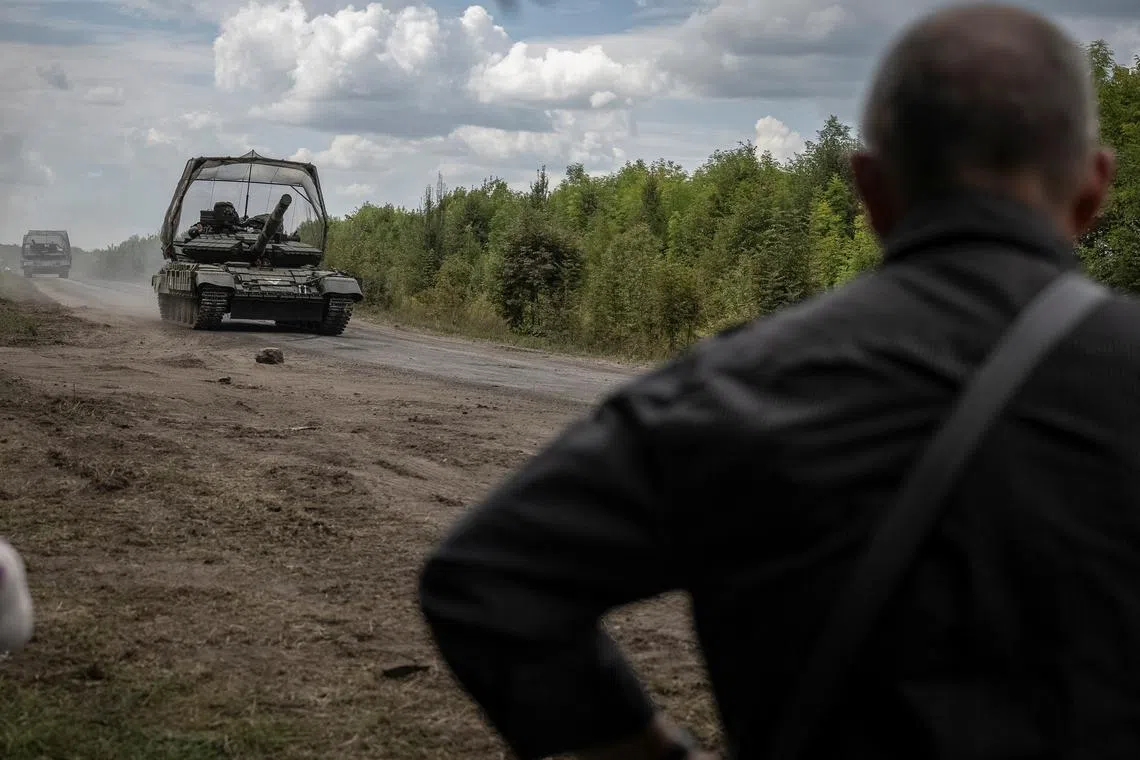Zelensky acknowledges military operation in Russia’s Kursk region
Sign up now: Get ST's newsletters delivered to your inbox

Ukrainian servicemen riding on tanks near the Russian border in northern Sumy region on Aug 10.
PHOTO: REUTERS
Follow topic:
KYIV – Ukrainian President Volodymyr Zelensky on Aug 10 acknowledged for the first time that Ukrainian forces were fighting in Russia’s Kursk region and said the operation was part of Kyiv’s drive to restore justice after Russia’s 2022 invasion.
Moscow’s forces are in their sixth day of intense battles against Kyiv’s largest incursion into Russian territory since the start of the war, which left south-western parts of Russia vulnerable before reinforcements started arriving.
Russia said Ukrainian forces pushed into the Kursk region on Aug 6
In a sign of the gravity of the situation, Russia imposed a sweeping security regime in three border regions on Aug 10, while Belarus, a staunch ally of Moscow, sent more troops to its border with Ukraine, accusing Kyiv of violating its airspace.
Security forces and the military have sweeping emergency powers during “counter-terror” operations. Movement is restricted, vehicles can be seized, phone calls can be monitored, areas are declared no-go zones, checkpoints are introduced, and security can be beefed up at key infrastructure sites.
Mr Zelensky had previously stayed silent about the operation but on Aug 10, in his nightly video address, he said he had discussed the operation with top Ukrainian commander Oleksandr Syrskyi,
“Today, I received several reports from commander-in-chief Syrskyi regarding the front lines and our actions to push the war onto the aggressor’s territory,” he said. “Ukraine is proving that it can indeed restore justice and ensure the necessary pressure on the aggressor.”
While neither side has provided precise details on Ukraine’s incursion, Russia’s Defence Ministry on Aug 10 said it had hit some Ukrainian positions as far as 10km from the border. It also reported hitting Ukrainian troops in areas 30km apart – an indication as to the breadth, as well as depth, of Ukraine’s advance.
Russian military bloggers say fighting is taking place as deep as 20km inside the Kursk region, prompting some of them to question why Ukraine was able to pierce the area so easily.
Russian President Vladimir Putin cast the Ukrainian attack – which military analysts say caught the Kremlin off guard – as a major provocation.
Russia’s top general Valery Gerasimov said on Aug 7 that the attacks had been halted, but Russia has thus far failed to push the Ukrainian forces back over the border.
Early on Aug 11, Kursk officials said 13 people were injured in the city after debris from a destroyed Ukraine-launched missile fell onto a nine-storey residential building.
Mr Alexei Smirnov, Kursk’s acting governor, ordered the local authorities to speed up the evacuation of civilians in areas at risk. On Aug 10, Russia’s Tass state news agency reported that more than 76,000 people had been evacuated.
Emergency aid has been ferried into the border area and extra trains to the capital Moscow have been put on for people fleeing the fighting.
“The war has come to us,” one woman – who declined to give her name – told AFP after arriving at a Moscow train station on Aug 9.
Both Kyiv and Moscow deny targeting civilians in their attacks in the war, which has killed thousands of people and displaced millions of Ukrainians, and has no end in sight.
Russia’s nuclear agency on Aug 10 warned of a “direct threat” to the nearby Kursk nuclear power station, less than 50km from the fighting.
“The actions of the Ukrainian army pose a direct threat” to the Kursk plant in western Russia, state news agencies cited its atomic energy agency Rosatom as saying.
On Aug 9, the head of the International Atomic Energy Agency, expressing similar concerns, had called for “maximum restraint”.
On the streets of Moscow on Aug 10, AFP journalists found support for tough measures to quell the response, but also some anger at how the incursion had been allowed to happen.
“We have to take all the steps that are possible in such a situation,” said Mr Alexander Ilyin, a 42-year-old architect. REUTERS, AFP

